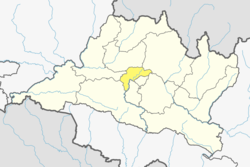Dakshinkali Municipality दक्षिणकाली नगरपालिका | |
|---|---|
 Dakshinkali in 2009 | |
| Coordinates: 27°35′0″N85°15′0″E / 27.58333°N 85.25000°E | |
| Country | |
| Province | Bagmati |
| District | Kathmandu |
| Established | December 2014 |
| Named after | Dakshinkali Temple |
| Government | |
| • Mayor | Mohan Basnet (NC) |
| • Deputy Mayor | Basanti Tamang (Dangol) (NC) |
| Area | |
• Total | 42.6 km2 (16.4 sq mi) |
| Population | |
• Total | 26,372 |
| • Density | 619/km2 (1,600/sq mi) |
| • Ethnicities | Newar Bahun Chhetri Tamang Magar |
| Time zone | UTC+5:45 (NST) |
| Website | www |
Dakshinkali is a municipality in Kathmandu District in the Province No. 3 of Nepal that was established on 2 December 2014 by merging the former Village development committees Chalnakhel, Chhaimale, Sheshnarayan, Sokhel, Talku Dudechaur and Old-Dakshinkali. [1] [2] The municipality's name means 'Southern Kali' and refers to a several centuries old temple complex that lies in the vicinity.











